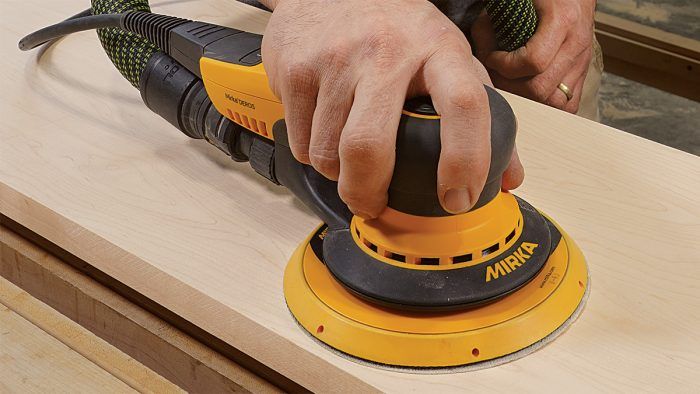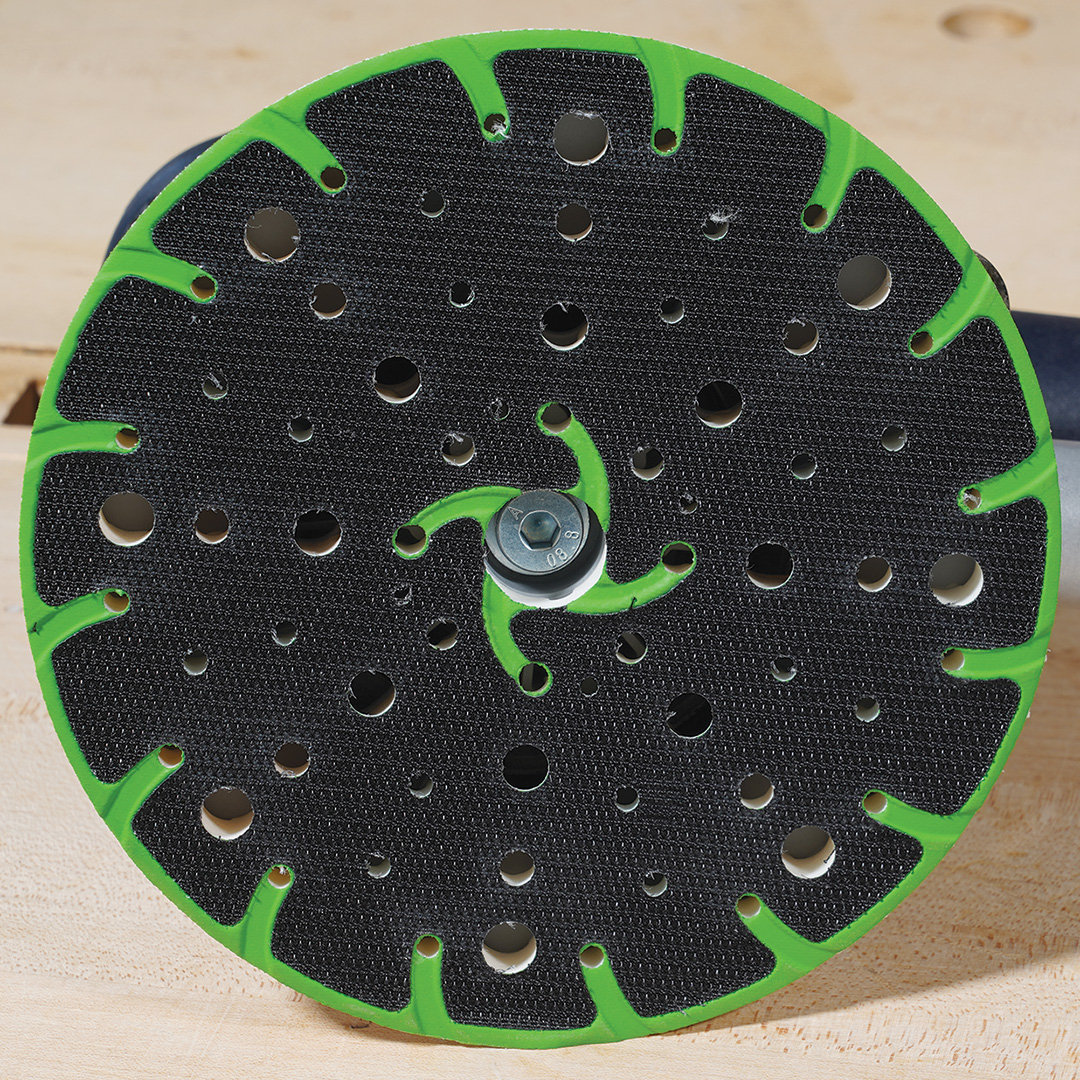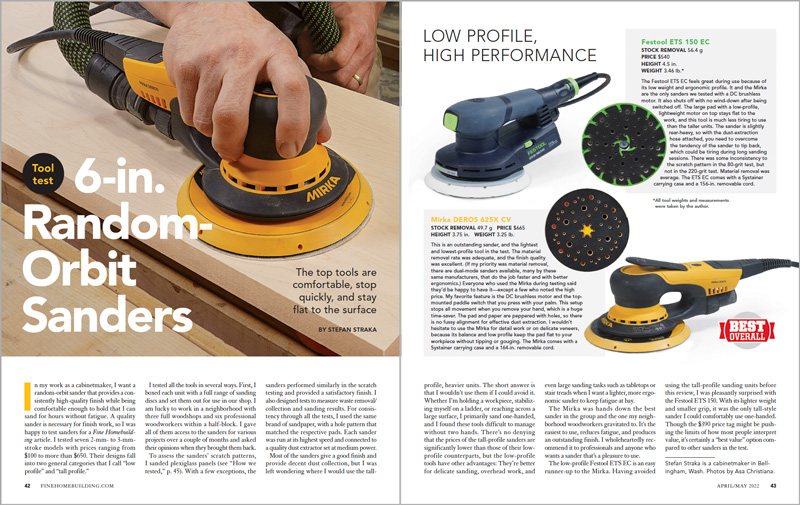6-in. Random-Orbit Sanders
The top tools are comfortable, stop quickly, and stay flat to the surface.

In my work as a cabinetmaker, I want a random-orbit sander that provides a consistently high-quality finish while being comfortable enough to hold that I can sand for hours without fatigue. A quality sander is necessary for finish work, so I was happy to test sanders for a Fine Homebuilding article. I tested seven 2-mm- to 3-mm-stroke models with prices ranging from $100 to more than $650. Their designs fall into two general categories that I call “low profile” and “tall profile.”
I tested all the tools in several ways.
First, I boxed each unit with a full range of sanding discs and set them out for use in our shop. I am lucky to work in a neighborhood with three full woodshops and six professional woodworkers within a half-block. I gave all of them access to the sanders for various projects over a couple of months and asked their opinions when they brought them back.
To assess the sanders’ scratch patterns, I sanded plexiglass panels. With a few exceptions, the sanders performed similarly in the scratch testing and provided a satisfactory finish. I also designed tests to measure waste removal/collection and sanding results. For consistency through all the tests, I used the same brand of sandpaper, with a hole pattern that matched the respective pads. Each sander was run at its highest speed and connected to a quality dust extractor set at medium power.
Most of the sanders give a good finish and provide decent dust collection, but I was left wondering where I would use the tall-profile, heavier units. The short answer is that I wouldn’t use them if I could avoid it. Whether I’m holding a workpiece, stabilizing myself on a ladder, or reaching across a large surface, I primarily sand one-handed, and I found these tools difficult to manage without two hands. There’s no denying that the prices of the tall-profile sanders are significantly lower than those of their low-profile counterparts, but the low-profile tools have other advantages: They’re better for delicate sanding, overhead work, and even large sanding tasks such as tabletops or stair treads when I want a lighter, more ergonomic sander to keep fatigue at bay.
The Mirka was hands down the best sander in the group and the one my neighborhood woodworkers gravitated to. It’s the easiest to use, reduces fatigue, and produces an outstanding finish. I wholeheartedly recommend it to professionals and anyone who wants a sander that’s a pleasure to use.
The low-profile Festool ETS EC is an easy runner-up to the Mirka. Having avoided using the tall-profile sanding units before this review, I was pleasantly surprised with the Festool ETS 150. With its lighter weight and smaller grip, it was the only tall-style sander I could comfortably use one-handed. Though the $390 price tag might be pushing the limits of how most people interpret value, it’s certainly a “best value” option compared to other sanders in the test.
Low profile, high performance
Festool ETS 150 EC
 Stock removal: 56.4 g
Stock removal: 56.4 g
Price: $540
Height: 4.5 in.
Weight: 3.46 lb.*
The Festool ETS EC feels great during use because of its low weight and ergonomic profile. It and the Mirka are the only sanders we tested with a DC brushless motor. It also shuts off with no wind-down after being switched off. The large pad with a low-profile, lightweight motor on top stays flat to the work, and this tool is much less tiring to use than the taller units. The sander is slightly rear-heavy, so with the dust-extraction hose attached, you need to overcome the tendency of the sander to tip back, which could be tiring during long sanding sessions. There was some inconsistency to the scratch pattern in the 80-grit test, but not in the 220-grit test. Material removal was average. The ETS EC comes with a Systainer carrying case and a 156-in. removable cord.
Mirka DEROS 625X CV
Stock removal: 49.7 g
Price: $665
Height: 3.75 in.
Weight: 3.25 lb.
This is an outstanding sander, and the lightest and lowest-profile tool in the test. The material removal rate was adequate, and the finish quality was excellent. (If my priority was material removal, there are dual-mode sanders available, many by these same manufacturers, that do the job faster and with better ergonomics.) Everyone who used the Mirka during testing said they’d be happy to have it —except a few who noted the high price. My favorite feature is the DC brushless motor and the top-mounted paddle switch that you press with your palm. This setup stops all movement when you remove your hand, which is a huge time-saver. The pad and paper are peppered with holes, so there is no fussy alignment for effective dust extraction. I wouldn’t hesitate to use the MIrka for detail work or on delicate veneers, because its balance and low profile keep the pad flat to your workpiece without tipping or gouging. The Mirka comes with a Systainer carrying case and a 164-in. removable cord.
Tall profile, low cost
Festool ETS 150
Stock removal: 60.2 g
Price: $390
Height: 7.125 in.
Weight: 4.82 lb.
This was my favorite of the tall-profile sanders. It was the only one I could easily use one-handed, and I think it’s the best tall sander for smaller hands. It had great balance, and there was no jumping or pulling like I experienced with some of the heavier tall-profile units. I found that the ETS moved very evenly over the workpiece, and its low vibration didn’t leave me with any tingling in my hands or extra fatigue. The tool comes with a Systainer carrying case and a 156-in. removable cord.
Makita BO6030
Stock removal: 45 g
Price: $220
Height: 7.25 in.
Weight: 5.8 lb.
The Makita feels well balanced and has a very smooth operation. Unfortunately, it had the worst performance of the tools we tested, producing disc-sized swirl inconstancies in both the 80-grit and 220-grit scratch tests. The dust port was the smallest of all the sanders and required the most complicated adapter setup to connect to a dust extractor. The Makita has a permanently attached 96-in. cord.
Bosch GEX34-6
Stock removal: 120 g
Price: $250
Height: 7.5 in.
Weight: 5.7 lb.
Having worked with the older 5-in. version of the Bosch for many years, I expected to really like this sander. Even with such a high removal rate, however, the unit had no material escape collection—the exception of the three sanders with the highest removal rates. The biggest deficit of this tool is its size. The sander was the third-heaviest one tested, and its grip is so wide and deep that even my relatively large hand had trouble gripping it. Everyone who used it found it tiring on larger sanding projects and unwieldy on anything delicate. The Bosch comes with a 156-in. permanently attached cord.
Ridgid R2611
Stock removal: 87.7 g
Price: $100
Height: 7.25 in.
Weight: 6.7 lb.
The Ridgid had the second-best material removal rate and the second-worst dust collection. It was also the heaviest sander in the test group, which may have contributed to its poor balance. Several other testers and I noticed a tendency for the tool to rock or wobble. The dust port on the Ridgid will connect to both a 11/4– and a 2-in. extractor hose. This makes the rear of the tool very large and contributes to its awkwardness with anything but flat, wide-open sanding tasks. The sander comes with a 95-in. permanently attached cord.
Metabo SXE 450 TurboTec
Stock removal: 75.3 g
Price: $280
Height: 7.25 in.
Weight: 6 lb.
The well-balanced Metabo has an adjustable stroke size and a turbo mode that the other sanders don’t offer. The turbo mode felt like “turning it up to 11”—and left me wondering why it wasn’t the highest has speed of the standard range. After trying to follow the instructions for changing the oscillation mode, several of us gave up when we couldn’t distinguish any change in the results. The Metabo had a good removal rate, but it finished near the middle in dust collection. Its 90-in. permanently attached cord is the shortest of all the sanders.
Stefan Straka is a cabinetmaker in Bellingham, Wash. Photos by Asa Christiana.
* All tool weights and measurements were taken by the author.

From Fine Homebuilding #306
To view the entire article, please click the View PDF button below.
RELATED STORIES
- What’s the Difference: Fine-Finish Sanders: Orbital vs. Random Orbit
- Superior Sander
- Stress-Free Sander
Fine Homebuilding Recommended Products
Fine Homebuilding receives a commission for items purchased through links on this site, including Amazon Associates and other affiliate advertising programs.

Spyder Stinger Spade Bit

BOSCH Compact Router (PR20)

Milwaukee Cordless Tablesaw (2736)





















View Comments
As to the Bosch, what does "Even with such a high removal rate, however, the unit had no material escape collection" mean? Does it mean no dust went into the dust collector?